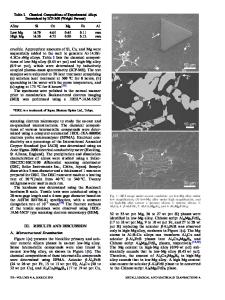Effects of Ta Addition on the Microstructure and Mechanical Properties of CoCu 0.5 FeNi High-Entropy Alloy
- PDF / 2,285,396 Bytes
- 7 Pages / 593.972 x 792 pts Page_size
- 21 Downloads / 354 Views
JMEPEG https://doi.org/10.1007/s11665-019-04463-8
Effects of Ta Addition on the Microstructure and Mechanical Properties of CoCu0.5FeNi High-Entropy Alloy Tingting Xu, Yiping Lu, Zhiqiang Cao, Tongmin Wang, and Tingju Li (Submitted May 7, 2019; in revised form October 31, 2019) In this work, the alloying effects of Ta element on the microstructure evolution and mechanical properties of CoCu0.5FeNiTax (x = 0-0.6 at.%) high-entropy alloys were studied. The microstructure changed from single solid solution to hypoeutectic, then to eutectic, and finally to hypereutectic with the increase in Ta content, which is because Ta element facilitates the Laves phase to form. The volume fraction of hard and brittle Laves phase increases with the Ta content, which increases the yield strength, Vickers hardness and theoretical density but decreases the plastic strain. The CoCu0.5FeNiTa0.1 alloy with a single FCC solid solution structure shows the optimal balance between density and ductility. The theoretical density and tensile fracture strain can reach 8.94 g/cm3 and 36.3%, respectively. Keywords
high-entropy microstructure
alloys,
mechanical
properties,
1. Introduction The shaped charges play an important role in the military combats and certain industries such as oil, mining and geological prospecting. In many applications, we hope the shaped charge jet can penetrate the target material as deep as possible. According to the model proposed by Birkhoff et al. (Ref 1), the penetration depth is positively correlated with the density and ductility of material used for the shaped charge liner (SCL). Therefore, many materials with high density and high ductility are selected to make SCL, such as Cu (Ref 2, 3), Ni (Ref 4, 5), W (Ref 6-9), Mo (Ref 10) and Ta (Ref 11-13). However, it is difficult for traditional liner materials represented by Cu and Ni to meet the requirements of modern applications. And it is difficult and expensive to fabricate more powerful liner materials represented by W and Ta. So finding a new liner material with high density and high ductility is very meaningful. In recent years, high-entropy alloys (HEAs) and multicomponent alloys firstly proposed by Yeh and Cantor et al. (Ref 14, 15) have attracted great interest within the materials science community (Ref 16-19). These unprecedented alloys with at least five metallic elements in equal or near equal atomic percent have higher mixing entropy and then promote the formation of simple solid solution (Ref 20, 21). Among them, the HEAs with FCC structure always show great ductility. For Tingting Xu, Yiping Lu, Zhiqiang Cao, Tongmin Wang, and Tingju Li, Key Laboratory of Solidification Control and Digital Preparation Technology (Liaoning Province), School of Materials Science and Engineering, Dalian University of Technology, Dalian 116024, PeopleÕs Republic of China. Contact e-mail: [email protected].
Journal of Materials Engineering and Performance
instance, Gludovatz et al. (Ref 22) studied the CrMnFeCoNi high-entropy alloy and found that it shows good tensile d
Data Loading...











